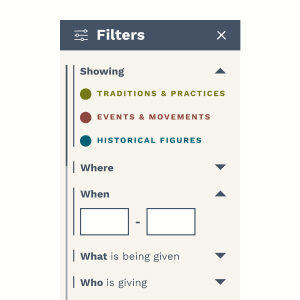Kindness and Generosity

Credit: ©Cecilie_Arcurs from Getty Images Signature via Canva.com
| Giver: | - |
|---|---|
| Receiver: | - |
| Gift: | - |
| Approach: | Other |
| Issues: | 1. No Poverty, 10. Reduced Inequalities, 11. Sustainable Cities and Communities, 13. Climate Action, 16. Peace, Justice and Strong Institutions, 2. Zero Hunger, 3. Good Health and Well-Being, 4. Quality Education, 5. Gender Equality, 6. Clean Water and Sanitation, 7. Affordable and Clean Energy, 8. Decent Work and Economic Growth, 9. Industry, Innovation and Infrastructure |
| Included in: | Kindness and Generosity |
The correlation between kindness and giving dates to antiquity. Indeed, the word philanthropy derives from the ancient Greek philanthropia, or “love of humanity,” a term believed to have been coined by the dramatist Aeschylus (c. 524-456 BCE) in his play Prometheus Bound. Stirred by feelings of compassion, the titan Prometheus steals fire from the gods and gives it to humankind. Although Prometheus is cruelly punished by Zeus, his act of self-sacrifice ultimately bestows a great benefit onto the human race.
Similar concepts developed in the ancient philosophical schools of China. In Confucianism, the spirit of selflessness is rooted in principles of ren (benevolence), shi (giving) and shu (reciprocity). Acts of kindness toward others cultivate feelings of mutual compassion and ethical responsibility, thereby reinforcing the moral bonds that maintain social order. One of the core ethical principles of Taoism, Ci, refers to a kindness that inspires people to engage in selfless giving, without expectation of reciprocity or reward.
Kindness holds a prominent place in the charitable traditions of most world religions. The concept of chesed – a Hebrew word suggesting “kindness” or “benevolence” – represents one of the core tenets of Jewish charity. In the New Testament, the spirit of generosity is rooted in Christ’s unconditional love for humanity. By performing acts of kindness toward others, Christians seek to emulate their savior’s example, promoting and reinforcing his ethos of compassion and benevolence. The Islamic concept of sadaqah (“truthfulness”) refers to a type of generosity that arises out of a sense of compassion for others, while the Sikh practice of seva, or selfless service to others, is rooted in feelings of kindness and empathy.
Compassion for other human beings – particularly those who have been marginalized by mainstream society – has inspired a number of modern philanthropic movements. During the 19th century, Dorothea Dix developed a more humane approach to caring for people with mental illness, while Elizabeth Fry led the campaign to reform the treatment of prison inmates. Pyotr Kropotkin (1842-1921) identified a biological basis underlying this concern for the collective good in his 1902 treatise “Mutual Aid: A Factor in Evolution.”
In the 1980s, writer and activist Anne Herbert (1950-2015) planted the seeds of a global philanthropic movement when she urged readers to “practice random kindness and senseless acts of beauty.” Oprah Winfrey encouraged her television viewers to adopt these same principles in their everyday lives, inspiring a pay-it-forward approach to generosity known as the Oprah Effect. Founded in 2012 by pop icon Lady Gaga (1986-), the Born This Way Foundation funds various efforts to cultivate interpersonal kindness as a key strategy for improving youth mental health.
For many people, feelings of kindness lie at the heart of their giving. While science-based philanthropic approaches – such as effective altruism – rely on data to guide funding decisions, generosity rooted in compassion derives from personal, emotional responses to the struggles of others. While difficult to quantify, these charitable impulses provide an invaluable impetus to philanthropic activity.
Contributor: Stephen Meyer
| Source type | Full citation | Link (DOI or URL) |
|---|---|---|
| Publication |
Anderson, Chris. Infectious Generosity: The Ultimate Idea Worth Spreading. New York: Crown, 2024. |
9780593727553 |
| Publication |
Arya, Bhavya, Kuany, and Nandini Chatterjee Singh. “Kindness: The Force That Will Help Us Achieve Sustainable Development Goals.” The Blue Dot, no. 9 (2018): 22-33. |
https://unesdoc.unesco.org/ark:/48223/pf0000373161/PDF/373159eng.pdf.multi.nameddest=373161/ |
| Publication |
Brodrick, Melissa. “The Heart and Science of Kindness.” Harvard Health Blog. Harvard Health Publishing, April 18, 2019. |
https://www.health.harvard.edu/blog/the-heart-and-science-of-kindness-2019041816447 |
| Publication |
Kelemen, Mihaela, Anita Mangan, and Susan Moffat. “More Than a ‘Little Act of Kindness’? Towards a Typology of Volunteering as Unpaid Work.” Sociology 51, no. 6 (December 2017): 1239-56. |
https://www.jstor.org/stable/26944625 |
| Book |
Phillips, Adam, and Barbara Taylor. On Kindness. New York: Farrar, Straus and Giroux, 2009. |
9780374226503 |


